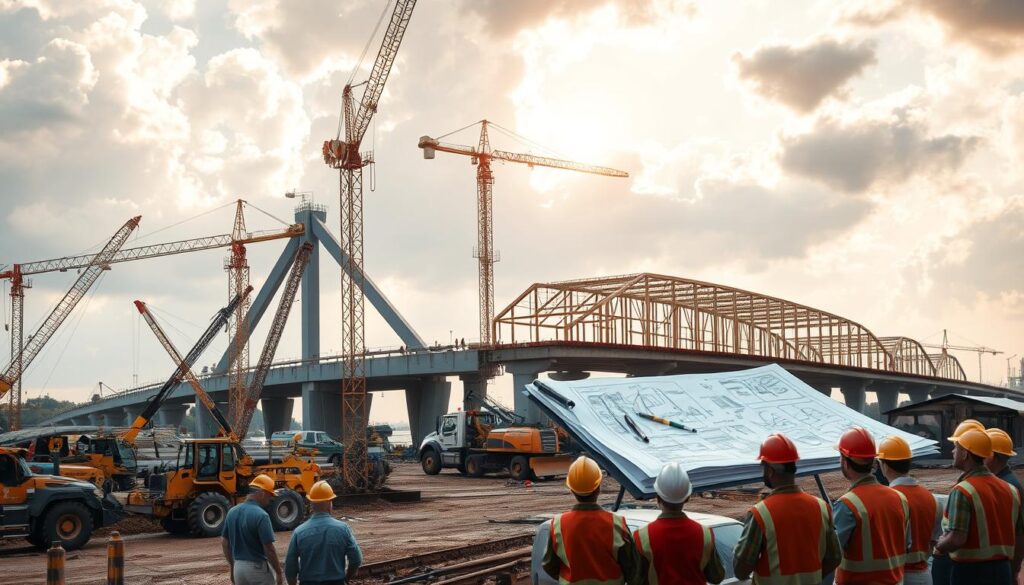The infrastructure of our communities is the backbone of modern society, supporting everything from daily commutes to economic development. Infrastructure development is crucial, with a significant impact on the quality of life for residents and businesses.
Did you know that the American Society of Civil Engineers estimates that the United States needs to invest over $2 trillion in infrastructure by 2025 to maintain current conditions and keep pace with growth? This is where public works engineering plays a vital role, driving projects that range from road repairs and water main upgrades to park renovations and stormwater management.
For more insights on how GIS technology is revolutionizing public works and engineering, you can explore the resources available on Esri’s MediaSpace channel, which features webinars and discussions on optimizing operations and maintenance through geo-AI and more.
Key Takeaways
- Infrastructure development is critical for community growth and economic development.
- Public works engineering drives essential infrastructure projects.
- Investing in infrastructure is vital for maintaining current conditions and supporting future growth.
- GIS technology plays a significant role in optimizing public works operations.
- Effective infrastructure planning enhances the quality of life for residents and businesses.
What is Public Works Engineering?
At its core, public works engineering is about creating and maintaining the infrastructure that supports modern society. This field is crucial for the development and upkeep of roads, bridges, public buildings, and other critical infrastructure.
Definition and Scope
Public works engineering encompasses a broad range of activities, including designing, building, and maintaining infrastructure. It involves civil engineering services to ensure that projects are executed efficiently and effectively. The scope of public works engineering is vast, covering various aspects of infrastructure development.
The field requires a deep understanding of municipal construction projects, including the complexities of urban planning and the need for sustainable practices. Public works engineers must balance the needs of the community with the constraints of budget and regulatory requirements.
Key Responsibilities
Public works engineers are responsible for a variety of tasks, including project management, design, and maintenance of infrastructure. They must ensure that projects are completed on time, within budget, and to the required quality standards.
- Designing and planning infrastructure projects
- Managing construction projects
- Maintaining existing infrastructure
Importance in Society
The importance of public works engineering in society cannot be overstated. It plays a critical role in supporting economic growth, improving the quality of life, and ensuring public safety. By developing and maintaining infrastructure, public works engineers contribute to the well-being of communities.
Effective public works engineering also involves engaging with the community and understanding their needs. This ensures that projects are tailored to meet the specific requirements of the area, enhancing their impact and relevance.
The Role of Public Works Engineers
The role of public works engineers is multifaceted, involving project management, design and planning, and community engagement. Public works engineers are responsible for overseeing infrastructure projects from conception through to completion, ensuring that they are delivered on time, within budget, and to the required quality standards.
Project Management
Effective project management is crucial in public works engineering. It involves coordinating various stakeholders, including contractors, government agencies, and the public. Public works engineers must ensure that projects are executed according to plan, managing resources, and mitigating risks.
A key aspect of project management is transportation planning. Public works engineers design and manage transportation systems, including roads, highways, and public transit systems, to ensure efficient and safe travel for communities.

Design and Planning
The design and planning phase is critical in public works engineering. It involves creating detailed plans and specifications for infrastructure projects, taking into account factors such as environmental engineering, sustainability, and community needs.
Public works engineers use various tools and techniques, including Geographic Information Systems (GIS) and Building Information Modeling (BIM), to design and plan projects. They must also conduct environmental impact assessments to minimize the ecological footprint of infrastructure projects.
| Design Consideration | Importance | Example |
|---|---|---|
| Environmental Impact | High | Conducting environmental assessments to minimize project impact |
| Sustainability | High | Using eco-friendly materials and practices |
| Community Needs | Medium | Engaging with the community to understand project requirements |
Community Engagement
Community engagement is a vital aspect of public works engineering. Public works engineers must work closely with the community to understand their needs and concerns, ensuring that projects meet their requirements and expectations.
This involves conducting public meetings and workshops, gathering feedback, and being responsive to community concerns. Effective community engagement helps to build trust and support for infrastructure projects, reducing the likelihood of opposition and delays.
Types of Public Works Projects
The scope of public works projects is broad, covering road construction, water management, and public transportation systems. These projects are fundamental to the development and functionality of modern society.
Road and Highway Construction
Road and highway construction is a critical aspect of public works projects, facilitating transportation and connectivity. Efficient road networks are essential for economic growth, as they enable the smooth movement of goods and people.
The construction process involves planning, design, and execution, taking into account factors like traffic volume, safety, and environmental impact. Modern road construction often incorporates sustainable practices and innovative materials to enhance durability and reduce environmental footprint.
Water Supply and Wastewater Management
Water supply and wastewater management are vital public works projects that ensure communities have access to clean water and proper sanitation. These systems are crucial for public health and environmental protection.
The management of water resources involves complex systems for water treatment, distribution, and wastewater collection and treatment. Effective management practices are necessary to conserve water resources and protect against waterborne diseases.
| Project Type | Description | Benefits |
|---|---|---|
| Road Construction | Involves building new roads or upgrading existing ones | Improves traffic flow, enhances safety, and supports economic development |
| Water Supply Management | Ensures the availability of clean water for communities | Protects public health, supports economic activities, and conserves water resources |
| Public Transportation Systems | Includes the development of buses, trains, and other public transit options | Reduces traffic congestion, decreases air pollution, and enhances mobility for citizens |
Public Transportation Systems
Public transportation systems are a key component of public works projects, providing citizens with efficient and affordable travel options. These systems help reduce traffic congestion, decrease air pollution, and promote sustainable urban development.
The development of public transportation involves planning and implementing various modes of transport, such as buses and trains, to meet the needs of the community. Effective public transportation systems require ongoing maintenance and upgrades to ensure reliability and efficiency.
The Process of Public Works Engineering
Effective public works engineering involves a systematic process that includes feasibility studies, environmental assessments, and project execution. This process is crucial for the successful delivery of infrastructure projects.

Feasibility Studies
The first step in the public works engineering process is conducting feasibility studies. These studies assess the practicality of a proposed project by evaluating factors such as cost, technical complexity, and potential environmental impact. According to the American Public Works Association, feasibility studies are essential for determining whether a project is viable.
- Evaluating project costs and benefits
- Assessing technical feasibility
- Identifying potential environmental impacts
Environmental Impact Assessments
Once a project is deemed feasible, the next step is to conduct an environmental impact assessment. This involves analyzing the potential effects of the project on the environment and identifying measures to mitigate any negative impacts. Environmental engineering plays a critical role in this stage, ensuring that infrastructure development is carried out in an environmentally responsible manner.
- Conducting environmental impact studies
- Developing strategies for environmental mitigation
- Ensuring compliance with environmental regulations
For more information on managing civil engineering projects, including environmental considerations, visit World Civil Society.
Project Execution
The final stage in the public works engineering process is project execution. This involves the actual construction or implementation of the project, following the plans and specifications developed during the previous stages. Effective project execution requires careful planning, coordination, and monitoring to ensure that the project is completed on time, within budget, and to the required quality standards.
By following this systematic process, public works engineers can ensure the successful delivery of infrastructure projects that meet the needs of the community while minimizing environmental impacts.
Challenges in Public Works Engineering
Despite its importance, public works engineering encounters several obstacles that can impact the success of municipal construction projects. Effective project management and community engagement are crucial in overcoming these challenges.
Funding and Budget Constraints
One of the primary challenges faced by public works engineers is securing sufficient funding for projects. Budget constraints can limit the scope and quality of infrastructure development. To address this, public works engineers must be adept at project management, ensuring that resources are allocated efficiently.
Regulatory Compliance
Public works projects must comply with a myriad of regulations and standards. Ensuring regulatory compliance is essential to avoid legal issues and project delays. Engineers must stay updated on changing regulations and implement them effectively in their projects.
Public Opposition and Support
Gaining public support is vital for the success of public works projects. However, engineers often face opposition from the community due to concerns about project impacts. Engaging with the public and addressing their concerns through transparent communication can help build trust and support for the projects.
The challenges in public works engineering can be significant, but with careful planning, effective management, and community engagement, many of these obstacles can be overcome. Understanding the complexities involved is the first step towards delivering successful public works projects.
| Challenge | Description | Mitigation Strategy |
|---|---|---|
| Funding and Budget Constraints | Limited financial resources for project execution | Efficient project management and resource allocation |
| Regulatory Compliance | Adhering to laws and regulations governing public works | Staying updated on regulations and effective implementation |
| Public Opposition and Support | Community resistance to public works projects | Public engagement and transparent communication |
Innovations in Public Works Engineering
Public works engineering is at the forefront of incorporating sustainable and smart technologies into infrastructure projects. This integration is transforming the way infrastructure is developed and managed, enhancing the quality of life for communities.
Sustainable Practices
Sustainable practices are becoming increasingly important in public works engineering. The use of eco-friendly materials, such as recycled asphalt and low-carbon concrete, is reducing the environmental impact of infrastructure projects. Additionally, practices like rainwater harvesting and greywater reuse are being adopted to conserve water resources.
For instance, the use of permeable pavements is gaining popularity as it allows rainwater to percolate through, reducing stormwater runoff and filtering out pollutants. This not only helps in managing stormwater more effectively but also in recharging groundwater.
| Sustainable Practice | Benefit |
|---|---|
| Recycled Materials | Reduces waste and conserves natural resources |
| Permeable Pavements | Manages stormwater runoff and recharges groundwater |
| Rainwater Harvesting | Conserves water resources |
Smart City Technologies
Smart city technologies are revolutionizing urban development initiatives by making cities more efficient, sustainable, and livable. Technologies such as IoT sensors, data analytics, and smart grids are being integrated into infrastructure projects to enhance their functionality and performance.
For example, smart traffic management systems use real-time data to optimize traffic flow, reducing congestion and lowering emissions. Similarly, smart energy grids manage energy distribution more efficiently, reducing waste and improving reliability.
To learn more about the trending technologies in public works, visit APWA’s Resources on Public Works Trending.

Use of Drones and Robotics
The use of drones and robotics is becoming increasingly prevalent in public works engineering. Drones are being used for site surveys, monitoring construction progress, and inspecting infrastructure. Robotics is being used for tasks such as maintenance and repair, improving safety and reducing costs.
For instance, drones equipped with thermal imaging cameras can inspect infrastructure for signs of damage or deterioration, allowing for early intervention. Robotics can be used for tasks like cleaning and maintaining infrastructure, reducing the need for human intervention in hazardous environments.
To explore how engineering is tackling future challenges, including the use of drones and robotics, visit World Civil Society’s page on Engineering the.
Importance of Sustainability
Public works engineering is increasingly embracing sustainability to mitigate its environmental footprint. This shift is driven by the need to reduce the environmental impact of infrastructure projects while promoting eco-friendly practices.
Eco-Friendly Materials
The use of eco-friendly materials is a crucial aspect of sustainable public works engineering. Materials such as recycled concrete, sustainable timber, and low-carbon cement are being increasingly adopted. For more information on sustainable building materials, visit this resource.
| Material | Environmental Benefit | Application |
|---|---|---|
| Recycled Concrete | Reduces waste and conserves natural resources | Road construction, building foundations |
| Sustainable Timber | Promotes forestry sustainability | Building construction, furniture |
| Low-Carbon Cement | Reduces carbon emissions | Concrete production |
Energy Efficiency Measures
Energy efficiency measures are another vital component of sustainable public works engineering. Implementing energy-efficient lighting, optimizing building insulation, and using renewable energy sources can significantly reduce energy consumption.
Long-Term Urban Planning
Long-term urban planning is essential for creating sustainable and resilient cities. This involves designing cities that are adaptable to future challenges, incorporating green spaces, and promoting mixed-use development.
Collaboration with Other Disciplines
Effective public works engineering relies heavily on collaboration with various disciplines to achieve successful project outcomes. This interdisciplinary approach ensures that infrastructure projects are not only technically sound but also environmentally sustainable and socially beneficial.

Civil Engineering
Civil engineering is a fundamental discipline that collaborates closely with public works engineering. Civil engineering services are crucial for the design, construction, and maintenance of infrastructure projects such as roads, bridges, and water treatment facilities. By working together, public works engineers and civil engineers can ensure that projects are executed efficiently and meet the required standards.
Environmental Science
Environmental science plays a vital role in public works engineering by providing insights into the environmental impact of infrastructure projects. Collaboration with environmental scientists enables public works engineers to develop projects that minimize environmental harm and comply with regulatory requirements. This includes assessing the potential environmental effects of projects and implementing measures to mitigate them.
Urban Planning and Design
Urban planning and design are essential components of public works engineering, particularly in the context of urban development initiatives. By collaborating with urban planners and designers, public works engineers can ensure that infrastructure projects are aligned with the broader urban development goals. This includes designing public spaces that are functional, sustainable, and aesthetically pleasing.
The benefits of interdisciplinary collaboration in public works engineering are numerous. It leads to more comprehensive project planning, better risk management, and improved project outcomes. Moreover, collaboration fosters innovation by bringing together diverse perspectives and expertise. As a result, public works engineering projects can better meet the needs of communities and contribute to sustainable development.
Professional Development in Public Works Engineering
To deliver successful infrastructure projects, public works engineers must prioritize their professional development. This involves staying updated with the latest technologies, best practices, and regulatory requirements. As the field continues to evolve, ongoing education and training are crucial for public works engineers to excel in their roles.
Education and Certification
A strong foundation in education is vital for public works engineers. Typically, a bachelor’s degree in civil engineering or a related field is required. Many professionals also pursue advanced degrees or certifications, such as the Professional Engineer (PE) license, to enhance their career prospects and expertise.
Certification programs, like those offered by the American Public Works Association (APWA), provide specialized training in areas such as construction inspection and project management. These programs not only improve technical skills but also demonstrate a commitment to professional excellence.
Continued Learning Opportunities
Continued learning is essential for public works engineers to stay current with industry advancements. This can be achieved through various means, including:
- Workshops and conferences
- Online courses and webinars
- Industry publications and research papers
For instance, the University of Wisconsin-Madison offers a course on Improving Public Works Construction Inspection Skills, which helps professionals enhance their inspection techniques and stay updated on best practices.
“The key to successful project delivery is not just about having the right technical skills, but also about staying informed and adapting to new challenges and opportunities.”
Networking and Professional Organizations
Networking and involvement in professional organizations play a significant role in the professional development of public works engineers. Organizations like the APWA and the American Society of Civil Engineers (ASCE) offer numerous benefits, including:
| Benefit | Description |
|---|---|
| Networking Opportunities | Connecting with peers and industry leaders |
| Professional Development | Access to training, workshops, and conferences |
| Industry Insights | Staying updated on industry trends and best practices |
By engaging with these organizations, public works engineers can expand their professional network, stay informed about industry developments, and contribute to the advancement of the field.
The Future of Public Works Engineering
As we look to the future, public works engineering is poised to undergo significant transformations driven by emerging trends and technological advancements. The industry is expected to play a crucial role in infrastructure development and urban development initiatives, shaping the way cities and communities grow and evolve.
Trends Shaping the Industry
Several key trends are set to influence the future of public works engineering. One of the most significant is the increasing focus on sustainability and environmental stewardship. As concern about climate change grows, public works engineers are being called upon to design and implement projects that minimize environmental impact.
Another trend is the adoption of new technologies, such as smart city technologies and advanced materials, which are enhancing the efficiency and effectiveness of infrastructure projects.
| Trend | Description | Impact |
|---|---|---|
| Sustainability Focus | Increased emphasis on environmentally friendly practices | Reduced carbon footprint, enhanced eco-friendliness |
| Technological Advancements | Adoption of smart city technologies and advanced materials | Improved project efficiency, enhanced infrastructure performance |
| Climate Change Adaptation | Designing infrastructure to withstand climate-related stresses | Increased resilience, reduced vulnerability to climate impacts |
Adapting to Climate Change
Adapting to climate change is becoming a critical aspect of public works engineering. This involves not only designing infrastructure that can withstand the impacts of climate change but also implementing measures to reduce the carbon footprint of projects. Strategies include using eco-friendly materials and incorporating energy efficiency measures into infrastructure design.

Embracing Technology
The future of public works engineering will also be characterized by its embrace of technology. From the use of drones for site monitoring to the application of Building Information Modelling (BIM) for project planning, technology is set to revolutionize the way public works projects are delivered.
By embracing these trends and technologies, public works engineering can continue to play a vital role in shaping the infrastructure of the future, making it more sustainable, resilient, and responsive to the needs of communities.
Case Studies in Successful Public Works Projects
Examining case studies of successful public works projects reveals valuable insights into best practices in public works engineering and municipal construction projects. These projects not only enhance infrastructure but also contribute to the overall quality of life for communities.
Iconic Infrastructure Developments
Several public works projects stand out for their innovative design and execution. For instance, the City of Logan’s use of Enterprise GIS to drive public works efficiencies is a notable example. As described on Esri’s website, this project showcases how technology can enhance municipal construction projects.
| Project | Location | Impact |
|---|---|---|
| Water Supply System Upgrade | City of Logan | Improved water quality and supply |
| Public Transportation System | Various Cities | Enhanced mobility and reduced congestion |
| Road and Highway Construction | Multiple Regions | Increased connectivity and safety |
Lessons Learned from Past Projects
Analyzing past public works engineering projects provides crucial lessons for future developments. Key takeaways include the importance of community engagement, thorough planning, and adaptability in project management.
By understanding these elements, future municipal construction projects can be better designed and executed, ultimately benefiting the communities they serve.
The Impact of Public Policy
The impact of public policy on public works engineering cannot be overstated, as it influences various aspects of infrastructure development. Public policy decisions have a direct effect on the funding, planning, and execution of public works projects.

Government Funding Initiatives
Government funding initiatives play a crucial role in supporting public works projects. These initiatives can take various forms, including grants, loans, and public-private partnerships. Effective funding initiatives can help to:
- Support the development of critical infrastructure
- Stimulate local economies through job creation
- Enhance the overall quality of life for communities
Regulatory Changes
Regulatory changes can significantly impact public works engineering. Changes in regulations can affect the planning, design, and execution of infrastructure projects. For instance, new environmental regulations may require the use of sustainable materials or practices, while changes in safety regulations may necessitate the adoption of new technologies or methodologies.
Key areas affected by regulatory changes include:
- Environmental impact assessments
- Safety standards and protocols
- Procurement processes for materials and services
Community Involvement in Decision-Making
Community involvement is essential in the decision-making process for public works projects. By engaging with local stakeholders, public works engineers can ensure that projects meet the needs and expectations of the community. This can involve:
- Public meetings and workshops
- Surveys and feedback mechanisms
- Collaborative planning processes
Effective community involvement can lead to more successful project outcomes, as it fosters a sense of ownership and cooperation among stakeholders.
Careers in Public Works Engineering
The field of public works engineering is rich with opportunities for professionals to grow and develop their careers. With a wide range of applications, from road construction to water management systems, public works engineering offers a diverse and dynamic career path.
Job Opportunities and Pathways
Public works engineering encompasses various job roles, including project managers, design engineers, and construction supervisors. Professionals in this field can explore opportunities in government agencies, private construction companies, and consulting firms. For fresh graduates, there are numerous civil engineering job opportunities available in public works engineering.
Skills Required for Success
To succeed in public works engineering, professionals need a combination of technical skills, such as knowledge of engineering principles and construction methods, and soft skills, like project management and communication. Key skills include problem-solving, teamwork, and adaptability. Engineers must also stay updated with the latest technologies and practices in the field.
Career Advancement and Specializations
As professionals gain experience, they can advance to senior roles or specialize in specific areas, such as sustainable infrastructure or transportation systems. Career advancement opportunities may include leadership positions, where individuals oversee large projects or teams. Specializing in emerging areas like smart city technologies can also enhance career prospects.
By understanding the career opportunities and pathways available in public works engineering, individuals can make informed decisions about their professional development. With the right skills and experience, professionals can build rewarding careers in this vital field.
Funding Sources for Public Works Projects
The success of infrastructure development projects often hinges on identifying the right funding sources. Public works projects are crucial for the development and maintenance of a region’s infrastructure, including roads, bridges, water supply systems, and public transportation.
There are several funding sources available for public works projects, each with its own advantages and requirements. Understanding these options is essential for project planners and stakeholders.
Federal and State Grants
Federal and state grants are a significant source of funding for public works projects. These grants are typically allocated for specific types of projects, such as highway construction, water quality improvement, or public transportation enhancements.
Types of Grants:
- Formula grants: Distributed based on a predetermined formula.
- Discretionary grants: Awarded based on the merits of the project.
- Competitive grants: Projects compete for funding based on specific criteria.
Public-Private Partnerships
Public-private partnerships (PPPs) involve collaboration between government agencies and private sector companies to finance, develop, and operate public infrastructure projects.
Benefits of PPPs:
- Bringing in private sector expertise and efficiency.
- Reducing the financial burden on government.
- Accelerating project delivery through streamlined processes.
Examples of successful PPPs include toll roads, public transportation systems, and water treatment facilities.
Local Government Financing
Local governments also play a crucial role in financing public works projects through various mechanisms, including bonds, taxes, and fees.
| Financing Mechanism | Description | Typical Use |
|---|---|---|
| Municipal Bonds | Issued by local governments to raise capital for large projects. | Infrastructure projects, such as roads and public buildings. |
| Property Taxes | Levied on property owners to fund local services and infrastructure. | General fund for local government services and infrastructure. |
| User Fees | Charges for services or usage of infrastructure. | Water and wastewater services, toll roads. |
By understanding and leveraging these funding sources, public works projects can be successfully financed and implemented, contributing to the overall development of infrastructure.

The Importance of Community Engagement
Effective community engagement is crucial for the success of public works projects, as it fosters a collaborative environment between engineers, stakeholders, and the community. By engaging with the community, public works engineers can better understand local needs and preferences, ultimately leading to more successful and sustainable infrastructure projects.
Stakeholder Identification
Identifying stakeholders is a critical step in community engagement. Stakeholders include local residents, business owners, community groups, and government agencies that may be impacted by or have an interest in the project. Effective stakeholder identification ensures that all relevant parties are informed and involved throughout the project lifecycle.
A thorough stakeholder analysis helps in understanding the diverse needs and concerns of the community. This can be achieved through various methods, including surveys, interviews, and public meetings.
| Stakeholder Group | Interests/Concerns | Engagement Strategies |
|---|---|---|
| Local Residents | Impact on daily life, project benefits | Public meetings, surveys |
| Business Owners | Economic impact, access | Workshops, one-on-one meetings |
| Community Groups | Project alignment with community goals | Regular updates, community events |
Public Meetings and Workshops
Public meetings and workshops are essential tools for community engagement. These forums provide opportunities for stakeholders to learn about project plans, ask questions, and provide feedback. Interactive workshops can be particularly effective, as they allow for hands-on participation and collaboration.
During these meetings, it’s crucial to present information in a clear and accessible manner. Visual aids, such as maps and diagrams, can help in communicating complex project details.

Feedback and Responsiveness
Collecting and responding to community feedback is a vital aspect of community engagement. It demonstrates a commitment to transparency and accountability, helping to build trust between the project team and the community.
Feedback mechanisms can include online surveys, comment boxes at public meetings, and dedicated project hotlines. Responding promptly to community concerns and incorporating feedback into project planning can significantly enhance project outcomes.
By prioritizing community engagement, public works engineers can ensure that infrastructure projects are not only technically sound but also socially and environmentally responsible.
Conclusion: The Value of Public Works Engineering
Public works engineering plays a vital role in shaping the infrastructure that supports modern society. By investing in public works engineering, communities can ensure a high quality of life, prepare for future needs, and build resilience against various challenges.
Quality Infrastructure
Effective public works engineering leads to the development of quality infrastructure, including roads, bridges, water supply systems, and public transportation. This infrastructure is crucial for the daily functioning of communities and supports economic growth through infrastructure development.
Future-Ready Communities
By embracing innovations and sustainable practices in public works engineering, communities can better prepare for future challenges, such as population growth and climate change. This proactive approach ensures that infrastructure remains resilient and adaptable.
Resilience and Sustainability
Building resilient communities through public works engineering involves not only constructing robust infrastructure but also incorporating sustainable practices and materials. This holistic approach enhances the overall well-being of communities and supports long-term sustainability goals.
